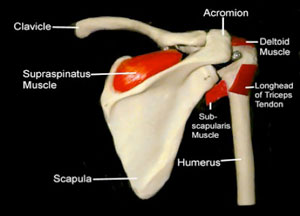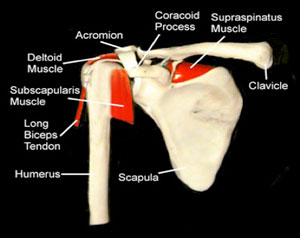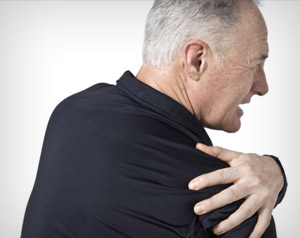To be seventy years young is sometimes far more cheerful and hopeful than to be forty years old
Oliver Wendall Holmes
Shoulder Conditions
How the shoulder works

The shoulder is the most flexible joint in your body which allows a wide range of arm motion, rotation, speed and power. The shoulder is made up of three bones:
- Scapula (Shoulder blade)
- Humerus (Upper arm bone)
- Clavicle (Collarbone)
Two joints facilitate shoulder movement.
The acromioclavicular (AC) joint is located between the acromion (part of the scapula that forms the highest point of the shoulder) and the clavicle. The glenohumeral joint, commonly called the shoulder joint, is a ball-and-socket type joint that helps move the shoulder forward and backward and allows the arm to rotate in a circular fashion or hinge out and up away from the body. (The "ball" is the top, rounded portion of the upper arm bone or humerus; the "socket," or glenoid, is a dish-shaped part of the outer edge of the scapula into which the ball fits.)
The capsule is a soft tissue envelope that encircles the glenohumeral joint. It is lined by a thin, smooth synovial membrane.
Shoulder problems and treatments

Bursitis or Tendonitis
If the rotator cuff and bursa are irritated, inflamed, and swollen, they may become, squeezed between the head of the humerus and the acromion. Repeated activities such as swimming, painting, etc can results in overuse. Motion involving the arms, or the aging process involving shoulder motion over many years, may also irritate and wear down the tendons, muscles, and surrounding structures.
Modifying activities and undertaking a rehabilitation program (physiotherapy) for the shoulder may be initial treatment. A cortisone injection may also be instilled.
Non-surgical options are successful in the majority of cases.
If unsuccessful, surgical options may be proceeded to, to remove the spurs on the acromion and repair the rotator cuff.
Impingement and partial rotator cuff tear

Overuse, aging, a fall on an outstretched hand, or a collision may inflame one or more of the rotator cuff tendons. Occupations requiring heavy lifting or sports requiring repeated overhead arm motion also place a strain on rotator cuff tendons and muscles. Normally, tendons are strong, but a longstanding wearing down process may lead to a tear.
In the early stages of this condition, impingement syndrome causes generalised shoulder aches. Raising the arm out to the side or in front of the body causes pain. Also difficulty with sleeping is experienced when rolling onto the affected side.
The shoulder may feel weak, especially when trying to lift the arm into a horizontal position. A person may also feel or hear a click or pop when the shoulder is moved.
As the condition progresses, pain worsens, discomfort increases, and a “catching” sensation is experienced when the arm is lowered. Weakness and an inability to raise the arm may indicate that the rotator cuff may be torn.
Signs of a Torn Rotator Cuff
Typically, a person with a rotator cuff injury feels pain over the deltoid muscle at the top and outer side of the shoulder, especially when the arm is raised or extended out from the side of the body. Motions like those involved in getting dressed can be painful.

- (07) 3812 3855
- Suite 3, 10 Pring Street, Ipswich, QLD 4305
-
Monday - Thursday 8:30am to 5:00pm
Friday 8:30am to 3:00pm
